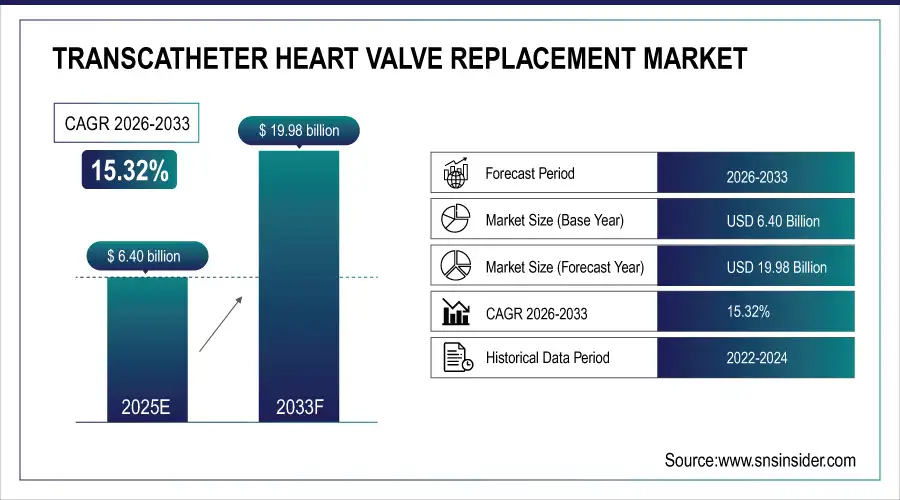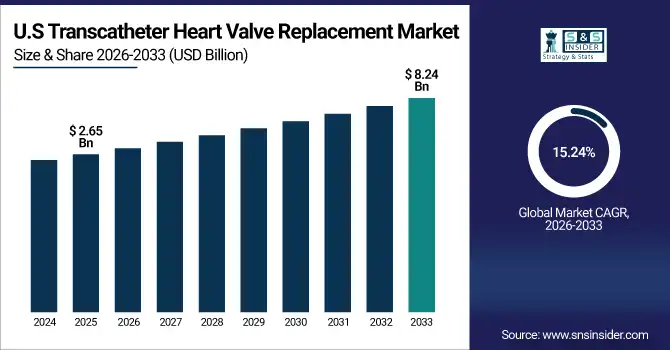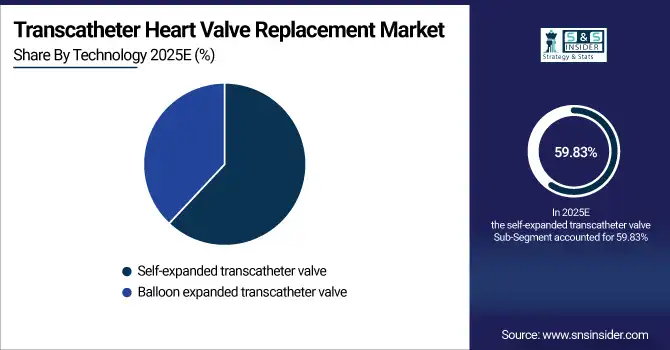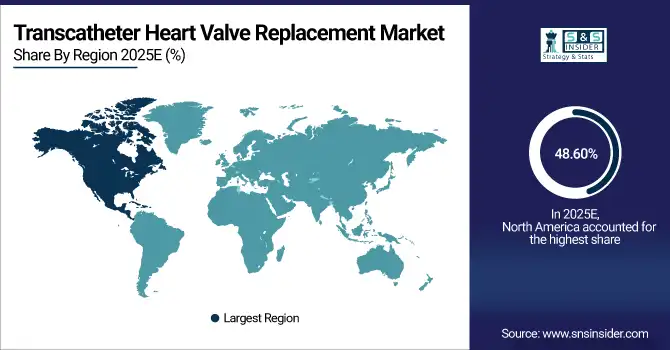Transcatheter Heart Valve Replacement Market Report Scope & Overview:
The transcatheter heart valve replacement market size was valued at USD 6.40 billion in 2025E and is projected to reach USD 19.98 billion by 2033, growing at a CAGR of 15.32% during 2026-2033.
The global transcatheter heart valve replacement market is expanding as the prevalence of valvular heart diseases, particularly aortic stenosis and mitral regurgitation, continues to rise globally. With cardiovascular diseases being a leading health burden, the growing elderly population is contributing significantly to this demand. A key transcatheter heart valve replacement market trend is the increasing preference for minimally invasive solutions that provide safer, more efficient treatment alternatives compared to traditional open-heart surgery.
For instance, in June 2024, the American Heart Association reported that aortic stenosis affects 12.4% of people aged 75+, with 1.5 million Americans having moderate-to-severe disease.
Market Size and Forecast:
-
Market Size in 2025: USD 6.40 billion
-
Market Size by 2033: USD 19.98 billion
-
CAGR: 15.32% from 2026 to 2033
-
Base Year: 2025
-
Forecast Period: 2026–2033
-
Historical Data: 2022–2024

To Get more information On Transcatheter Heart Valve Replacement Market - Request Free Sample Report
Transcatheter Heart Valve Replacement Market Trends
-
Rising prevalence of aortic stenosis and mitral regurgitation in elderly populations is accelerating demand for Transcatheter Heart Valve Replacements as safer alternatives to surgical valve replacement.
-
Continuous advancements in balloon-expandable, self-expandable, and mechanically expandable valve designs are enhancing durability, reducing complications, and improving clinical outcomes in complex patient anatomies.
-
Expanding indications of TAVR from high-risk to intermediate- and low-risk patients are broadening the eligible patient pool, fueling rapid global adoption.
-
Favorable reimbursement policies and government-backed cardiac care programs are improving access to Transcatheter Heart Valve Replacement procedures in both developed and emerging markets.
-
Integration of imaging, robotics, and AI-assisted navigation systems is supporting real-time precision, lowering procedural errors, and improving post-operative recovery.
-
Collaborations between device manufacturers, hospitals, and research institutes are driving innovation in next-generation heart valve technologies and increasing clinical trial activity.
-
Growing preference for minimally invasive and outpatient-based procedures is pushing adoption in ambulatory and catheterization labs, particularly in North America and Europe.
U.S. Transcatheter Heart Valve Replacement Market Insights
The U.S. transcatheter heart valve replacement market size was valued at USD 2.65 billion in 2025E and is projected to reach USD 8.24 billion by 2033, growing at a CAGR of 15.24% during 2026-2033. The US dominates the transcatheter heart valve replacement market because it has a large aging population with a high prevalence of aortic stenosis, strong adoption of minimally invasive procedures, and robust reimbursement frameworks. The country benefits from advanced healthcare infrastructure, early FDA approvals, and high availability of skilled interventional cardiologists. Additionally, strong R&D investments by key players, rapid uptake of next-generation valve technologies, and extensive clinical trial activity further strengthen US leadership in the transcatheter heart valve replacement market.

Transcatheter Heart Valve Replacement Market Growth Drivers:
-
Growing Clinical Trial Evidence Supporting Safety and Long-Term Durability Driving Transcatheter Heart Valve Replacement Consumption Growth
The global transcatheter heart valve replacement market is being strongly driven by growing clinical trial evidence that supports the safety, efficacy, and long-term durability of transcatheter valves. Recent multi-center studies and real-world registries consistently demonstrate lower complication rates, improved survival, and enhanced quality of life compared to traditional surgery. This mounting scientific validation is boosting physician confidence, accelerating regulatory approvals, and encouraging broader adoption of advanced transcatheter technologies across diverse patient groups globally.
For instance, in May 2025, JACC published a study showing that transcatheter aortic valve replacement reduced major complications by 25% compared to surgery in intermediate-risk patients, highlighting improved safety outcomes.
Transcatheter Heart Valve Replacement Market Restraints:
-
Post-Procedure Complications Limit Market Expansion Globally
The global transcatheter heart valve replacement market faces restraints due to post-procedure complications, which remain a concern despite technological advancements. Patients undergoing TAVR are at risk of paravalvular leaks, valve thrombosis, conduction abnormalities, and long-term durability issues. These safety challenges raise caution among clinicians and regulatory bodies, impacting confidence in adoption. Addressing these risks through improved device design, advanced imaging guidance, and long-term clinical evidence is essential to accelerate market penetration and patient trust globally.
Transcatheter Heart Valve Replacement Market Opportunities:
-
Next-Generation Valve Technologies Create Growth Opportunities for the Transcatheter Heart Valve Replacement Market
The global transcatheter heart valve replacement market is witnessing significant opportunity through the development of next-generation valve technologies. Innovative features, including repositionable and retrievable valves, enhanced durability, and improved sealing mechanisms, are addressing key clinical challenges including paravalvular leaks and valve misplacement. These advancements not only improve patient safety and procedural success rates but also expand the eligible patient pool. As leading companies invest in R&D, these cutting-edge valves are expected to accelerate adoption globally.
For instance, in March 2025, Edwards Lifesciences reported its RESILIA tissue-based transcatheter valve showed 92% freedom from deterioration at 5 years, highlighting durability and next-generation technology success.
Transcatheter Heart Valve Replacement Market Segmentation Analysis
-
By product, self-expandable transcatheter aortic valves led the transcatheter heart valve replacement market with a 45.70% share in 2025e, while the mechanically expanded transcatheter aortic valves are the fastest-growing segment with a CAGR of 16.33%.
-
By application, the transcatheter aortic valve segment dominated the market with a 70.76% share in 2025e, while the transcatheter mitral valve is expected to grow fastest with a CAGR of 16.13%.
-
By technology, self-expanded transcatheter valve led the market with a 59.83% share in 2025e, while balloon-expanded transcatheter valve is registering the fastest growth with a CAGR of 15.66%.
-
By end user, hospitals held a 65.85%share in 2025e, while ambulatory surgical centers are growing the fastest with a CAGR of 16.59%.
By Product, Self-Expandable Transcatheter Aortic Valves Lead the Market, While Mechanically Expanded Transcatheter Aortic Valves Register the Fastest Growth
The self-expandable transcatheter aortic valve segment dominated the transcatheter heart valve replacement market in 2025E, due to their superior adaptability in complex anatomies, reduced risk of annular rupture, and ability for repositioning. Driving factors include rising adoption in high-risk patients, favorable long-term durability, expanding clinical evidence, and physician preference for improved safety and procedural flexibility. The mechanically expanded transcatheter aortic valves segment will grow at the highest CAGR over the forecast period, driven by precise deployment control, reduced paravalvular leak risk, and enhanced hemodynamic performance. Growing clinical adoption and expanding trials are accelerating their global market penetration.
By Application, Transcatheter aortic valve Dominates while Transcatheter mitral valve Shows Rapid Growth
The transcatheter aortic valve segment was estimated to be the largest revenue generator of the total market share in 2025E, driving factors include rising elderly population, strong clinical evidence supporting TAVR, minimally invasive benefits over surgery, faster recovery times, and continuous technological advancements improving safety, durability, and patient outcomes. For instance, the transcatheter mitral valve is also anticipated to be the fastest growing with a CAGR by 2026-2033, driven by rising mitral regurgitation prevalence, technological innovations, and expanding clinical trials. Favorable outcomes and increasing adoption in high-risk patients are accelerating their global growth.
By Technology, Self-expanded transcatheter valve Lead, While Balloon expanded transcatheter valve Register Fastest Growth
The self-expanded transcatheter valve segment accounted for the highest share of revenues in the transcatheter heart valve replacement market in the year 2025E, due to its flexibility in complex anatomies, ability to conform to irregular annuli, and lower risk of complications. Driving factors include high adoption in high-risk and elderly patients, robust clinical outcomes, and physician preference for procedural safety and efficiency. While the balloon expanded transcatheter valve segment is expected to achieve the fastest CAGR during the predicted period from 2026-2033, driven by precise deployment, high procedural accuracy, and strong clinical outcomes. Increasing adoption in specialized cardiac centers and expanding regulatory approvals are fueling their rapid market growth.

By End User, Hospital Lead, While Ambulatory Surgical Centers Grow Fastest
The hospital segment accounted for the largest share of the transcatheter heart valve replacement market in 2025E, as the primary centers for complex cardiac procedures. Driving factors include availability of advanced infrastructure, skilled interventional cardiologists, comprehensive post-operative care, high procedure volumes, and established reimbursement support, making hospitals the preferred setting for transcatheter valve interventions globally. The ambulatory surgical centers segment will have the highest CAGR over the forecast period 2026–2033, driven by minimally invasive procedures, shorter patient recovery times, lower costs, and increasing adoption of outpatient TAVR, expanding access beyond traditional hospital settings.
Transcatheter Heart Valve Replacement Market Regional Analysis:
North America Transcatheter Heart Valve Replacement Market Insights
North America dominates the transcatheter heart valve replacement market with a market share of 48.60% 2025E, due to advanced healthcare infrastructure, early regulatory approvals, and widespread reimbursement support. The region benefits from a large elderly population with high valvular disease prevalence, extensive clinical trial activity, and rapid adoption of minimally invasive procedures. Additionally, strong R&D investments by leading companies, high physician expertise, and well-established catheterization labs contribute to faster procedure adoption, superior patient outcomes, and sustained market leadership.

Get Customized Report as per Your Business Requirement - Enquiry Now
U.S. Transcatheter Heart Valve Replacement Market Insights
The US dominates North America’s transcatheter heart valve replacement market due to advanced healthcare infrastructure, early FDA approvals, high procedure volumes, strong reimbursement policies, widespread adoption of minimally invasive valves, and a large elderly population with significant valvular heart disease prevalence.
Asia-Pacific Transcatheter Heart Valve Replacement Market Insights
Asia-Pacific is the fastest-growing region in the transcatheter heart valve replacement market, registering a CAGR of 16.29% over the forecast period, due to rising prevalence of valvular heart diseases, an expanding elderly population, and increasing healthcare expenditure. Rapid development of catheterization labs, growing awareness of minimally invasive procedures, and improving access to advanced valve technologies are driving adoption. Additionally, government initiatives, favorable reimbursement programs, and collaborations between device manufacturers and local healthcare providers are accelerating market penetration, making Asia-Pacific a high-growth hub for transcatheter heart valve replacements.
China Transcatheter Heart Valve Replacement Market Insights
China leads the Asia-Pacific transcatheter heart valve replacement market due to rising cardiovascular disease prevalence, expanding healthcare infrastructure, growing adoption of minimally invasive procedures, increasing reimbursement support, and government initiatives promoting advanced cardiac care and access to next-generation valve technologies.
Europe Transcatheter Heart Valve Replacement Market Insights
Europe is the second-largest market for Transcatheter Heart Valve Replacement due to well-established healthcare infrastructure, high prevalence of valvular heart diseases, and early adoption of minimally invasive procedures. Strong reimbursement frameworks, extensive clinical trial activity, and a skilled workforce of interventional cardiologists support widespread procedure adoption. Additionally, the presence of leading valve manufacturers, continuous technological advancements, and growing patient awareness contribute to Europe’s sustained market growth and its position as the second-dominating region globally.
Germany Transcatheter Heart Valve Replacement Market Insights
Germany leads Europe’s transcatheter heart valve replacement market due to high prevalence of valvular heart diseases, advanced healthcare infrastructure, early adoption of minimally invasive TAVR procedures, strong reimbursement support, and well-established cardiac centers with skilled interventional cardiologists.
Latin America (LATAM) and Middle East & Africa (MEA) Transcatheter Heart Valve Replacement Market Insights
The Middle East & Africa and Latin America are emerging markets for Transcatheter Heart Valve Replacement, driven by rising cardiovascular disease prevalence, expanding geriatric populations, and improving healthcare infrastructure. Increased investments in catheterization labs, growing awareness of minimally invasive procedures, and collaborations between global device manufacturers and local healthcare providers are accelerating adoption. Favorable government initiatives and gradual reimbursement support are further enhancing access, positioning these regions as high-potential growth markets.
Transcatheter Heart Valve Replacement Market Competitive Landscape:
Edwards Lifesciences Corporation, founded in 1958 and headquartered in Irvine, California, USA, is a global leader in heart valve therapies and critical care monitoring. The company specializes in transcatheter aortic valves, surgical valves, and innovative technologies aimed at enhancing procedural safety and improving patient outcomes.
-
In March 2025, Edwards announced positive five-year results from its RESILIA tissue-based transcatheter valve, demonstrating 92% freedom from structural valve deterioration, highlighting long-term durability and reinforcing its leadership in TAVR technologies.
Medtronic plc, established in 1949 and headquartered in Dublin, Ireland, is a leading medical technology company focused on minimally invasive therapies. It develops transcatheter heart valves, pacemakers, and cardiac monitoring devices, emphasizing expanding access to structural heart treatments globally.
-
In October 2024, Medtronic received FDA approval for its Evolut FX TAVR system for low-risk patients, expanding its eligible patient pool and driving adoption in minimally invasive heart valve replacements.
Boston Scientific Corporation, founded in 1979 and headquartered in Marlborough, Massachusetts, USA, designs and manufactures transcatheter heart valves, cardiovascular devices, and interventional cardiology solutions. The company prioritizes innovation in minimally invasive procedures and increasing adoption in the treatment of structural heart diseases.
-
In June 2025, Boston Scientific completed a successful multicenter trial of its Lotus Edge transcatheter aortic valve, reporting improved procedural precision and reduced paravalvular leak rates, enhancing clinical outcomes and market competitiveness.
Transcatheter Heart Valve Replacement Market Key Players:
Some of the transcatheter heart valve replacement market Companies are:
-
Edwards Lifesciences Corporation
-
Medtronic plc
-
Boston Scientific Corporation
-
Abbott Laboratories
-
CryoLife, Inc.
-
JenaValve Technology, Inc.
-
Braile Biomédica
-
MicroPort Scientific Corporation
-
LivaNova PLC
-
Terumo Corporation
-
Shanghai MicroPort Medical
-
ValveTech, Inc.
-
CardiAQ Valve Technologies
-
MedValve GmbH
-
Venus Medtech
-
3f Biomedicine
-
Neovasc Inc.
-
Parker Hannifin
-
Innovheart SAS
-
Hansen Medical, Inc.
| Report Attributes | Details |
|---|---|
| Market Size in 2025 | USD 6.40 Billion |
| Market Size by 2033 | USD 19.98 Billion |
| CAGR | CAGR of 15.32 % From 2026 to 2033 |
| Base Year | 2025 |
| Forecast Period | 2026-2033 |
| Historical Data | 2022-2024 |
| Report Scope & Coverage | Market Size, Segments Analysis, Competitive Landscape, Regional Analysis, DROC & SWOT Analysis, Forecast Outlook |
| Key Segments | • By Product (Self-Expandable Transcatheter Aortic Valves, Balloon-Expandable Transcatheter Aortic Valves, Mechanically Expanded Transcatheter Aortic Valves) • By Application (Transcatheter aortic valve, Transcatheter pulmonary valve, Transcatheter mitral valve) • By Technology (Balloon expanded transcatheter valve, Self-expanded transcatheter valve) • By End User (Hospitals, Independent Cardiac Catheterization Labs, Ambulatory Surgical Centres) |
| Regional Analysis/Coverage | North America (US, Canada), Europe (Germany, UK, France, Italy, Spain, Russia, Poland, Rest of Europe), Asia Pacific (China, India, Japan, South Korea, Australia, ASEAN Countries, Rest of Asia Pacific), Middle East & Africa (UAE, Saudi Arabia, Qatar, South Africa, Rest of Middle East & Africa), Latin America (Brazil, Argentina, Mexico, Colombia, Rest of Latin America). |
| Company Profiles | Edwards Lifesciences Corporation, Medtronic plc, Boston Scientific Corporation, Abbott Laboratories, CryoLife, Inc., JenaValve Technology, Inc., Braile Biomédica, MicroPort Scientific Corporation, LivaNova PLC, Terumo Corporation, Shanghai MicroPort Medical, ValveTech, Inc., CardiAQ Valve Technologies, MedValve GmbH, Venus Medtech, 3f Biomedicine, Neovasc Inc. , Parker Hannifin, Innovheart SAS, Hansen Medical, Inc. and other players. |

